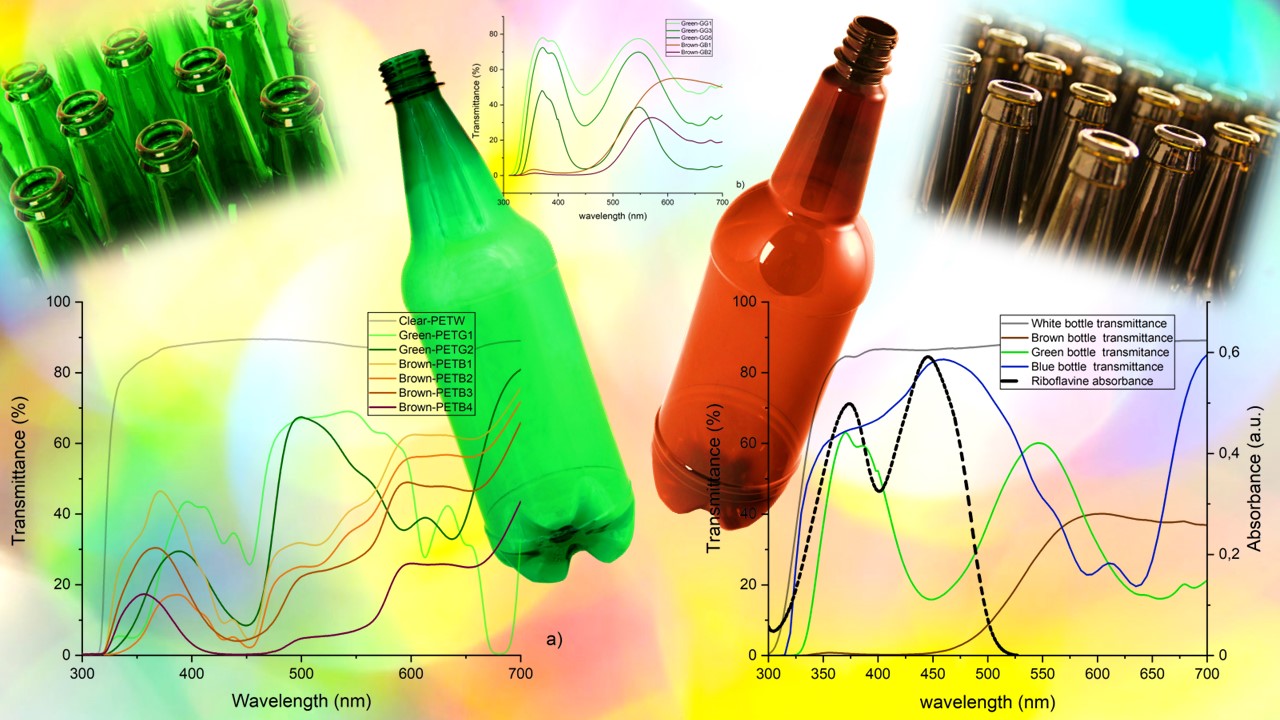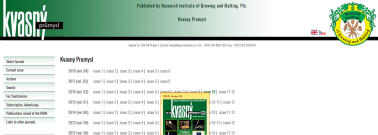Characterization of packaging ability to protect beer from light degradation and introduction of a new Packaging Riboflavin Index
DOI:
https://doi.org/10.18832/kp2022.68.679Keywords:
beer, light degradation, riboflavin, skunky flavour, light-struck flavour, 3-methyl-2butene-1-thiolAbstract
Bottled beer is exposed to light during transport or storage, which can unfavourably affect its sensory properties. One of the functions of the packaging is to provide maximum protection against possible light degradation. Riboflavin (vitamin B2), which acts as a photosensitizer, is a key substance for the occurrence of light degradation in beer. Riboflavin absorbs light in the visible region of the spectrum and transfers its energy to other compounds. A cascade of subsequent chemical reactions leads to sensory damage to the beer. Based on the transmission spectrum of packaging (glass and plastic), the Packaging Riboflavin Index (PRFI)was introduced. PRFI was designed as a tool which quantitatively assesses the ability of packaging to protect beer from light damage. The basic types of commercially used glass and plastic packaging were compared using this index. The validity of the index was verified in an experiment with defined light damage of beer in different packaging.
References
Bachvarov, V., Marinova, G. (2006). Investigation on the alteration of quality parameters of beer in PET bottles. Food Processing Industry Magazine.
Boutroy, N., Pernel, Y., Rius, J.M., Auger, F., Bardeleben, H.J. von, Cantin, J.L., Abel, F., Zeinert, A., Casiraghi, C., Ferrari, A.C., Robertson, J. (2006). Hydrogenated amorphous carbon film coating of PET bottles for gas diffusion barriers. Diamond and Related Materials, 15(4-8), 921–927. https://doi.org/10.1016/j.diamond.2005.10.049
Cahill, P.J., Ackerley, D.F., Barski, R.F., Chiang, W.C., Johnson, D.C., Nyderek, W.M., Rotter, G.E., Chen, S.Y. (2002). Zero oxygen permeation plastic bottle for beer and other applications. US Patent US6558762B2.
Christensen, I. (2003). Developments in Colorants for Plastics. iSmithers Rapra Publishing, pp.120. ISBN 978-1-85957-373-0
Di Felice, R., Cazzola, D., Cobror, S., Oriani, L. (2008). Oxygen permeation in PET bottles with passive and active walls. Packaging Technology and Science, 21, 405–415. https://doi.org/10.1002/pts.820
Folz (2010). Are plastic bottles ready to replace glass as a beer package? MBAA Technical Quarterly. https://doi.org/10.1094/TQ-47-3-0720-01
Gabriel, P., Sigler, K. (2018). A device monitoring turbidity and color changes of beverages directly in bottled samples. Kvasny Prumysl, 64(5), 224–232. https://doi.org/10.18832/kp201831
Gabriel, P., Škoda, J., Benešová, K., Matoulková, D. (2022). Direct detection of beer photodegradation in commercial bottles and introduction of a new Light-Struck Flavour Susceptibility Index. Kvasny Prumysl, 68(5), 656–662. https://doi.org/10.18832/kp2022.68.656
Gamer, L.S., Sanders, W.H., Andersen, J.L. (1964). Evaluation of amber bottles by photoelectric measurement of the transmitted light. Proceedings. Annual meeting - American Society of Brewing Chemists 22, 183–188. https://doi.org/10.1080/00960845.1964.12006757
Heyerick, A. (2001). Unraveling the mechanism of the lightstruck flavor of beer (PhD Thesis). Ghent University.
Jaskula-Goiris, B., De Causmaecker, B., De Rouck, G., Aerts, G., Paternoster, A., Braet, J., De Cooman, L. (2019). Influence of transport and storage conditions on beer quality and flavour stability: Influence of transport and storage conditions on beer quality and flavour stability. Journal of The Institute of Brewing, 125(1), 60–68. https://doi.org/10.1002/jib.535
Orzinski, M., Weber, I., Schneider, J. (2005). New requirements of the measurements of permeation through plastic bottles and closures. MBAA Technical Quarterly, 42, 346–351.
Pozdrik, R., Roddick, F., Rogers, P., J., Nguyen, T. (2006). Spectrophotometric method for exploring 3-methyl-2-butene-1-thiol (MBT) formation in lager. Journal of Agricultural and Food Chemistry, 54(17), 6123–6129. https://doi.org/10.1021/jf060515v
Profaizer, M. (2007). Shelf life of pet bottles estimated via a finite elements method simulation of carbon dioxide and oxygen permeability. Italian Food and Beverage Technology, 48, 5.
Sakuma, S., Rikimaru, Y., Kobayashi, K., Kowaka, M. (1991). Sunstruck flavor formation in beer. Journal of the American Society of Brewing Chemists, 49(4), 162–165. https://doi.org/10.1094/ASBCJ-49-0162
Stowitts, A. (2015). Beer in PET: The Answer to Beer Packaging Challenges. MBAA Technical Quarterly. https://doi.org/10.1094/TQ-52-2-0502-01
Taylor, E.C., Poole, J.P. (1971). A method for evaluating the light protection of amber glass. Proceedings. Annual meeting - American Society of Brewing Chemists 29, 238–245. https://doi.org/10.1080/00960845.1971.12007022
Templar, J., Arrigan, K., Simpson, W.J. (1995). Formation, measurement and significance of lightstruck flavor in beer: A review. Brewers Digest 70, 18–25.
Myers, D. (2013). The Color of Art Pigment Database: Pigment Brown, PBr. In: artiscreation.com [online]. [cit.30. 11. 2022]. Retreived from: http://artiscreation.com/brown.html

Downloads
Published
How to Cite
Issue
Section
License
Copyright (c) 2022 Petr Gabriel, Miroslav Dienstbier, Karel Fous, Dagmar Matoulková

This work is licensed under a Creative Commons Attribution 4.0 International License.







